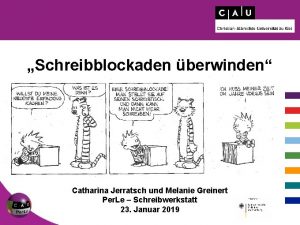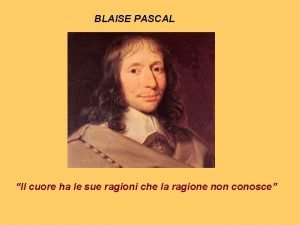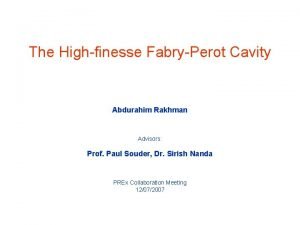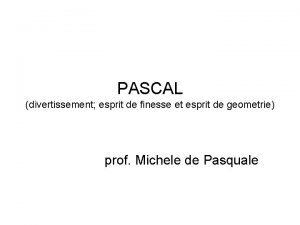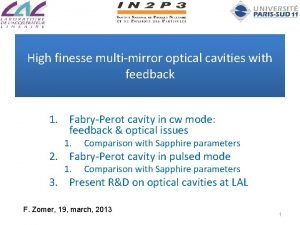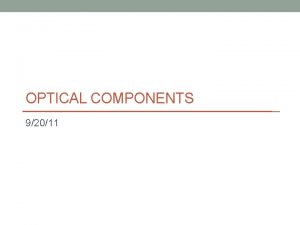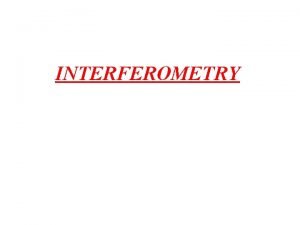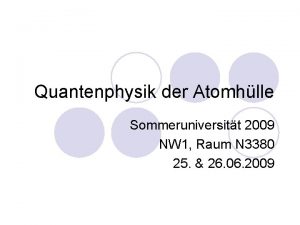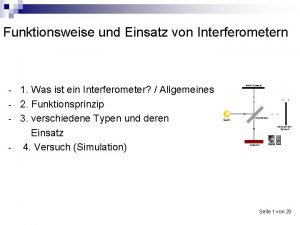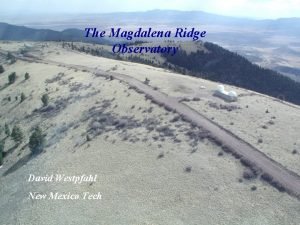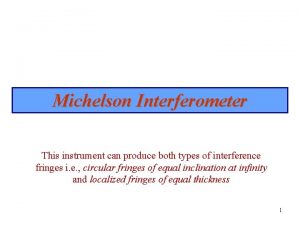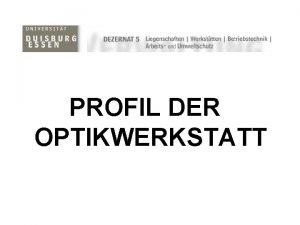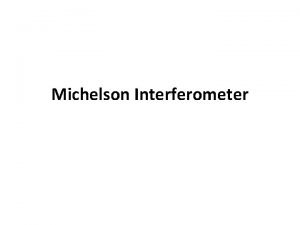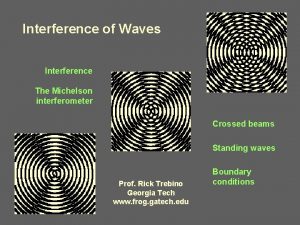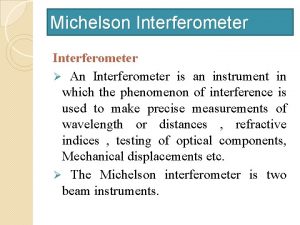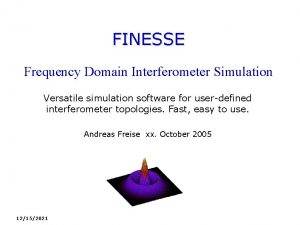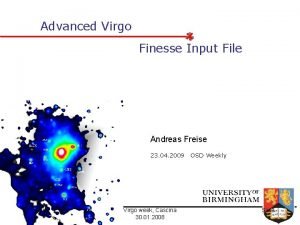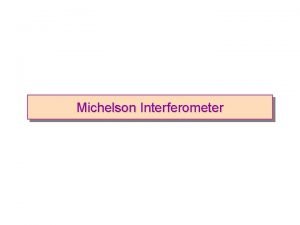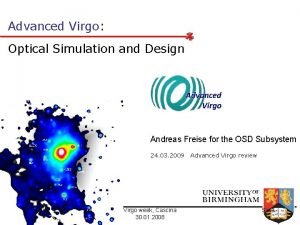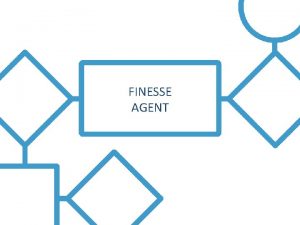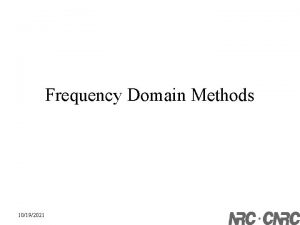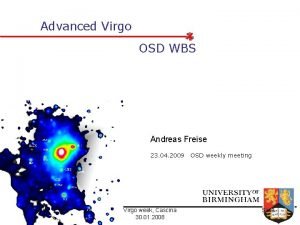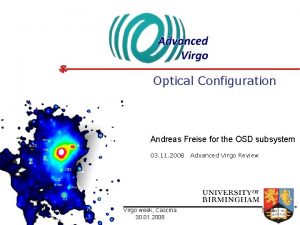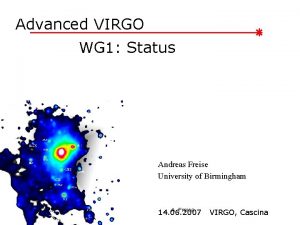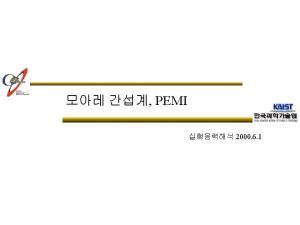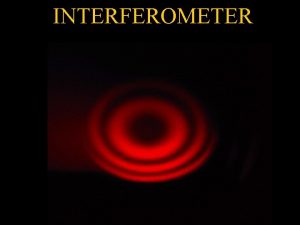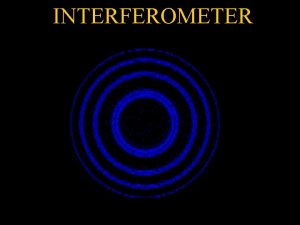FINESSE Frequency Domain Interferometer Simulation Andreas Freise European






















- Slides: 22

FINESSE Frequency Domain Interferometer Simulation Andreas Freise European Gravitational Observatory 17. March 2004 9/25/2020

5. September 2003 Andreas Freise

Possible Outputs of FINESSE light power, field amplitudes eigenmodes, beam shape error/control signals (modulation-demodulation) transfer functions, sensitivities, noise couplings alignment error signals, mode matching, etc. 5. September 2003 Andreas Freise

Plane Waves – Frequency Domain Coupling of light fields: Set of linear equations: solved numerically 5. September 2003 Andreas Freise

Frequency Domain Simple cavity: two mirrors + one space (4 nodes) Light source (laser) Output signal (detector) 5. September 2003 Andreas Freise

Frequency Domain one Fourier frequency one complex output signal 5. September 2003 Andreas Freise

Static response phase modulation = sidebands 3 fields, 3 beat signals 5. September 2003 Andreas Freise

Frequency Response infenitesimal phase modulation 9 frequencies, 13 beat signals 5. September 2003 Andreas Freise

Gaussian Beam Parameters start node Compute cavity eigenmodes Trace beam and set beam parameters 5. September 2003 Andreas Freise

Mode Mismatch and Misalignment Mode mismatch or misalignemt can be described as light scattering in higher-order spatial modes. Coupling coefficiants for the interferometer matrix are derived by projecting beam 1 on beam 2: 5. September 2003 Andreas Freise

FINESSE: Fast and (fairly) well tested Example: Optical layout of GEO 600 (80 nodes) TEM order O matrix elements (effective) computation time (100 data points) 0 ~25000 340 <1 sec 5 ~11000000 83000 400 sec The Hermite-Gauss analysis has been validated by: computing mode-cleaner autoalignment error signals (G. Heinzel) comparing it to Opto. Cad (program for tracing Gaussian beams by R. Schilling) comparing it to FFT propagation simulations (R. Schilling) 5. September 2003 Andreas Freise

Power Recycling Signals 5. September 2003 Andreas Freise

FINESSE http: //www. rzg. mpg. de/~adf/ Windows, Linux /virgo/VCS/1. 0/VIRGOSW/Finesse/v 0 r 93/. . . Linux, AIX 5. September 2003 Andreas Freise

5. September 2003 Andreas Freise

Using Par-Axial Modes Hermite-Gauss modes allow to analyse the optical system with respect to alignment and beam shape. Both misalignment and mismatch of beam shapes (mode mismatch) can be described as scattering of light into higherorder spatial modes. This means that the spatial modes are coupled where an optical component is misaligned and where the beam sizes are not matched. 5. September 2003 Andreas Freise

From Plane Waves to Par-Axial Modes The electric field is described as a sum of the frequency components and Hermite-Gauss modes: Example: lowest-order Hermite-Gauss: Gaussian beam parameter q 5. September 2003 Andreas Freise

Gaussian Beam Parameters Transforming Gaussian beam parameters by optical elements with ABCD matrices: Example: normal incidence transmission through a curved surface: 5. September 2003 Andreas Freise

Frequency Noise Coupling of a frequency calibration peak into the dark fringe output: Difference between results for TEM 00 only and those with higher-order TEM modes: factor 100 phase 90° 5. September 2003 Andreas Freise

Mode Healing 1. 0 0. 1 TMSR 0. 01 5. September 2003 Andreas Freise

Mode Healing Each recycling cavity minimises the loss due to mode mismatch of the respective other power recycling only: with signal recycling: 5. September 2003 Andreas Freise

Typical Tasks For FINESSE Error signals, control signals photo detectors, multiple mixers Transfer functions amplitude-, phase- and frequency modulations Shot-noise-limited sensitivities 5. September 2003 Andreas Freise

FINESSE: Versatile simulation software for user-defined interferometer topologies. Fast, easy to use. Higher-order spatial modes: Commissioning of interferometers with highfinesse cavities requires to understand the influences of mode-matching and alignment on control signals and noise couplings. 5. September 2003 Andreas Freise
 Catharina jerratsch
Catharina jerratsch The z transform of np
The z transform of np Z domain to frequency domain
Z domain to frequency domain Fourier series of trapezoidal waveform
Fourier series of trapezoidal waveform Common z transform pairs
Common z transform pairs Esprit de geometrie
Esprit de geometrie Finesse of a cavity
Finesse of a cavity Esprit de finesse pascal
Esprit de finesse pascal Finesse of a cavity
Finesse of a cavity Optical finesse
Optical finesse Finesse agent desktop
Finesse agent desktop Pitter npl gauge interferometer
Pitter npl gauge interferometer Dreidimensionaler potentialtopf
Dreidimensionaler potentialtopf Weißlichinterferometer funktionsweise
Weißlichinterferometer funktionsweise Magdalena ridge observatory
Magdalena ridge observatory Michelson interferometer formula
Michelson interferometer formula Optikwerkstatt
Optikwerkstatt Prinsip kerja interferometer
Prinsip kerja interferometer Laser interferometer space antenna
Laser interferometer space antenna Michelson interferometer formula
Michelson interferometer formula What is the principle of michelson interferometer
What is the principle of michelson interferometer Form factor and crest factor
Form factor and crest factor Marginal relative frequency definition
Marginal relative frequency definition
